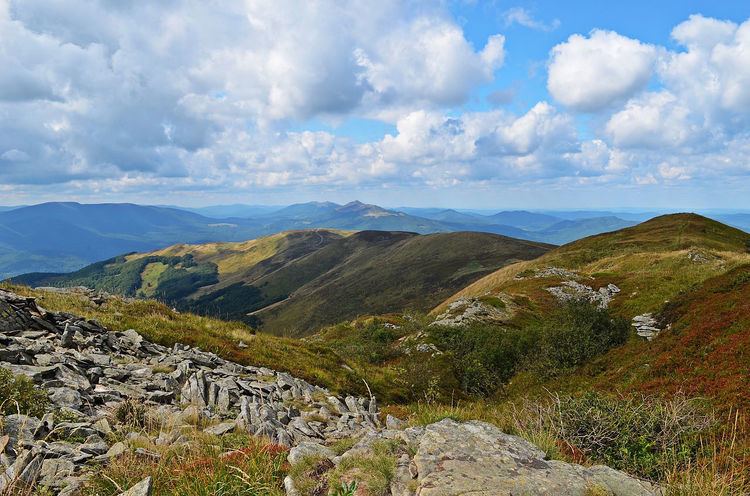Peak Pikuy | Elevation 1,405 m Passes Łupków Pass | |
 | ||
Parent range Połoniny, Warmian-Masurian Voivodeship Similar Lake Solina, Tarnica, Beskids, Low Beskids, Tatra Mountains | ||
Gopro horse riding in bieszczady mountains poland
Bieszczady [bʲɛˈʂt͡ʂadɨ] is a mountain range that runs from the extreme south-east of Poland through Ukraine and Slovakia. It forms the western part of the Eastern Beskids (Beskidy Wschodnie), and is more generally part of the Outer Eastern Carpathians. The mountain range is situated between the Łupków Pass (640 m) and the Vyshkovskyi Pass (933 m).
Contents
- Gopro horse riding in bieszczady mountains poland
- Map of Bieszczady Mountains Poland
- Term
- Division
- History
- Hiking trails
- Literature
- References
Map of Bieszczady Mountains, Poland
Frequently Bieszczady refers only to the Western Bieszczady or even only to the part of the range lying within Poland.
The highest peak of Bieszczady is Mt. Pikuy (1405 m) in Ukraine. The highest peak of the Polish part is Tarnica (1346 m).
Term
The term Bieszczady in the wide sense is used only in Poland. In Slovakia and Ukraine "Bieszczady" usually refers only to the part situated in Poland. In Poland "Bieszczady" also refers usually only to the Polish part of the (Western) Bieszczady. In Ukraine, the "Eastern Bieszczady" have various names (unstable terminology), they usually contain the word Beskids. In Slovakia the Slovak part is called Bukovec Mountains (Bukovské vrchy).
Historically, the terms Bieszczad and Beskid have been used for hundreds of years to describe the mountains separating Poland and Ruthenia from Hungary. They were known by the Latin name Poloniae Alpe Besczade.
A colloquial Polish term referring to Bieszczady is Biesy, because folk etymology connects the origin of the mountains to demonic (bies) activity.
The true etymology of the name "Bieszczady" is unknown. It may be related to Middle Low German beshêt, beskēt, meaning watershed.
Division
Since there exist many variants of divisions of the mountain ranges and names for the Beskids and Ukrainian Carpathians, several divisions are given in the following:
Division 1:
Division 2:
Division 3:
Division 4: In an old Ukrainian division, what is defined here as the Bieszczady in a wider sense corresponds to the western part of the Mid-Carpathian Depression and to the westernmost part of the Polonynian Beskids.
History
Settled in prehistoric times, the south-eastern Poland region that is now Bieszczady was overrun in pre-Roman times by various tribes, including the Celts, Goths and Vandals (Przeworsk culture and Puchov culture). After the fall of the Roman Empire, of which most of south-eastern Poland was part (all parts below the San), Hungarians and West Slavs invaded the area.
The region subsequently became part of the Great Moravian state. Upon the invasion of the Hungarian tribes into the heart of the Great Moravian Empire around 899, the Lendians of the area declared their allegiance to the Hungarians. The region then became a site of contention between Poland, Kievan Rus and Hungary starting in at least the 9th century.
This area was mentioned for the first time in 981, when Volodymyr the Great of Kievan Rus took the area over on the way into Poland. In 1018 it returned to Poland, 1031 back to Rus, in 1340 Casimir III of Poland recovered it.
Bieszczady was one of the strategically important areas of the Carpathian mountains bitterly contested in battles on the Eastern Front of World War I during the winter of 1914/1915.
Up until 1947, 84% of the population of the Polish part of the Bieszczadzkie Mountains was Boyko. The killing of the Polish General Karol Świerczewski in Jabłonki by the Ukrainian Insurgent Army in 1947 was the direct cause of the replacement of the Boykos, the so-called Operation Vistula. The area was mostly uninhabited afterward. In 2002, then president Aleksander Kwaśniewski expressed regret for this operation.
In 1991, the UNESCO East Carpathian Biosphere Reserve was created that encapsulates a large part of the area and continues into Slovakia and Ukraine. It comprises the Bieszczady National Park (Poland), Poloniny National Park (Slovakia) + Uzhansky National Nature Park (Ukraine). Animals living in this reserve include, among others, black storks, brown bears, wolves and bison.
